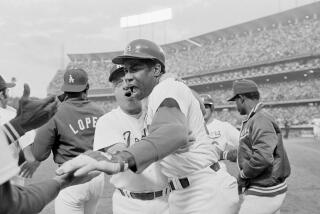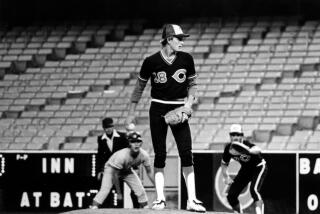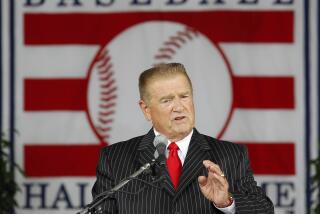Nailing It Down : Kansas City Pitcher Bud Black Helped Build More Than Just a Baseball Program at SDSU
KANSAS CITY — When a former collegiate pitcher returns to his alma mater, you might think he would head directly to the mound to toe the rubber and smooth out the dirt.
Left-hander Bud Black of the World Series champion Kansas City Royals has a different plan in mind when he attends the annual San Diego State alumni game at Smith Field today.
Black, who was 7-1 at SDSU in 1979 and holds the school record for strikeouts in a game with 16, will head straight to the clubhouse.
Rather than look for his old locker, Black wants to check the nails in the walls.
These aren’t just any nails. Black hammered them into place on cold, dark mornings in the fall of 1978 when he and his teammates built the clubhouse.
SDSU Coach Jim Dietz is the architect of both the Aztec baseball program and the clubhouse.
“When I first transferred to San Diego State as a junior, I wondered why the school didn’t just hire a contractor and build us a clubhouse,” Black said. “Then I realized things aren’t done that way here.
“Coach Dietz and his players built that clubhouse. Still to this day, it makes me appreciate it more.”
SDSU pitchers picked up wood at the lumber yard and then loosened their arms by hammering nails at 6 a.m. Infielders worked on the roofs and the outfielders poured cement.
Black is a control pitcher who is very crafty on the mound, but carpentry has never been his strong point.
“I wasn’t very crafty,” Black said. “If I find a crooked nail in the clubhouse, it is probably mine.”
The clubhouse at Smith Field has sentimental value to Black, but all clubhouses are his domain.
“I’ve always liked them,” Black said. “I’m one of the first guys to the park because I like to get in my T-shirt and shorts and hang out. I like the atmosphere and the camaraderie.
“After a game, I’m not one to hurry up and bolt. If I’ve had a bad game, I’ll think about it for a while.”
After he explores the nooks and crannies of the clubhouse he helped construct, Black will look for his fellow builders.
Tony Gwynn, Bobby Meacham and Black played on a SDSU team that won more than 50 games and lost to Pepperdine in an NCAA regional played at Michigan State.
“When I was playing, I could see that Tony and Bobby would make it to the big leagues,” Black said. “Tony was a big league hitter back then. Bobby had a lot of talent and desire. I also felt I’d get a chance to play professionally, but I didn’t know how far I’d go.
“Actually, I thought a few more guys from our team might have made it to the big leagues. But some were in the wrong place at the wrong time.”
And some were in the right place at the right time.
Gwynn, the Padre right fielder, led the majors in batting in 1984. Meacham starts at shortstop for the Yankees.
Black is a starter for a Royals team that dramatically won the 1985 American League Championship Series and World Series. Kansas City trailed Toronto and the St. Louis three games to one before winning the final three games.
“I don’t think of it (the championship) as a miracle or fluke, but it was a heck of a feat,” he said. “I’ve thought about it every day since the season ended.”
There was an eight-game stretch last season when Black spent a lot of long nights in the clubhouse with unhappy thoughts. That was when his losses were mounting nearly as fast as Steve Balboni’s home runs.
“I was concerned about Bud during that stretch,” said Dietz, who speaks to Black at least once a month. “Bud is a very, very fierce competitor. At first, he took it real bad when he was in a pitching slump.”
After compiling a 17-12 record with a 3.12 earned-run average and leading the Royals in seven pitching categories in 1984, Black began the 1985 season as the ace of the staff.
He defeated Toronto, 2-1, on opening day, and was 5-3 with a 2.84 ERA in late May. From May 21 through July 14, however, he lost seven of eight starts and had a 6.39 ERA.
“I pitched well in half those games and got hit pretty hard in some of them,” Black said. “But I never lost confidence. The frustrating part was I couldn’t consistently get it going.”
Nevertheless, Manager Dick Howser stuck with Black, who had never missed a start in his four-year major league career. Howser was not about to break the streak.
Howser’s confidence in him paid off when Black pitched his best game of the season in his 33rd start.
The Royals trailed the Angels by one game in the Western Division with five to play when the clubs took the field at Royals Stadium on Oct. 2. Black beat California, 4-0, on a three-hitter that moved the Royals into a tie for first place.
“That has to be one of the biggest games I’ve ever pitched,” Black said.
During the AL Championship Series, Black pitched in three games, including one start, and had a 1.69 ERA in 10 innings. He appeared in two games in the World Series, losing 3-0 as the starter in Game 4 and pitching 3 innings of shutout relief in Kansas City’s 5-3 win in Game 6.
It was a positive way to end a disappointing (10-15, 4.33 ERA) season.
For all the high school and junior college baseball players who have spent days and weeks, even months trying to get a college scholarship, the following story might be depressing.
During his sophomore year at Lower Columbia College, a junior college in Longview, Wash., Black stopped off at San Diego while he was in Southern California visiting his parents.
Dietz wasn’t in his office, so Black decided to leave a one-page, “Dear Coach” letter. He gave it to the secretary and went home.
“I probably made a fool of myself by leaving that letter,” Black said. “Then, a week later, Coach called me up and invited me to visit the campus.”
Black and Dietz toured the SDSU campus, Mission Bay and La Jolla. They walked and talked from 9 in the morning to 8 at night.
“That night at dinner, Coach said he had a scholarship for me if I wanted to come. The guy had never even seen me play.”
But Dietz knew Black had already turned down an opportunity to join the Giants’ organization earlier that year.
Dietz felt secure in offering the 162-pounder with an 83 m.p.h. fastball a scholarship.
Black improved from 6-5 with a 5.67 ERA in 1978 to 7-1 with a 3.35 ERA in 1979.
“I had always wanted to play collegiate baseball in Southern California,” Black said. “I wanted to see if the numbers I was compiling in the Northwest were legitimate.”
After being selected in the 17th round of the 1979 June free agent by the Seattle Mariners, Black’s next goal was to see if the numbers he had posted in his senior year at SDSU were legitimate.
In the spring of 1982, Black got his big break when he was sent to Kansas City to complete a deal for for infielder Manny Castillo.
“I was traded to a veteran pitching staff,” Black said. “Basically, I was the only left-hander in the organization under 30 years old. A left-hander who can throw strikes is a valuable commodity.”
And Dietz thinks he’ll be valuable after his pitching days are over.
“I can’t remember a lot of the specific games Bud pitched, but I remember he was a joy when he was here,” Dietz said. “Bud will always have a job here when his playing days are over.”
Hopefully, Black will be teaching pitchers how to throw curveballs and not how to pound nails.
More to Read
Go beyond the scoreboard
Get the latest on L.A.'s teams in the daily Sports Report newsletter.
You may occasionally receive promotional content from the Los Angeles Times.










